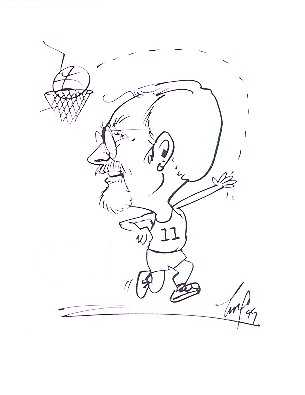Shagging Fungos (Two)
And this whole line of thought actually got started in a very different place, when some friends of mine were lamenting the disclosure that David Ortiz had tested positive for steroid use back in 2003 (or whenever those supposedly "confidential" tests were administered), and I complained instead about the ubiquitous performance-enhancing substance messages in our society, including this recent Dunkin' Donuts ad, where the mere addition of a free Turbo-Shot is enough to allow the scrawny second baseman to slay the giant with a well-placed fungo.
But what I discovered instead was that a good many of these same people, passionate baseball (well, let's say Red Sox) fans all, had only a vague idea about what a "fungo" really is. The dictionary definition is fungo: n. pl. -goes Baseball. A practice fly ball hit to a fielder with a specially designed bat. [Origin Unknown] but as you'll see from the linked article, there's a lot more to it than that. Meanwhile, here's a bit of a photo essay to help those of you who are visual learners to better understand the more intimate details.
 See that thing hanging down between Johnny Pesky's legs? That's his fungo, a bat designed expecially for hitting practice fly balls and grounders to players on the field. A fungo is generally both lighter and longer than a regular bat, with a much narrower barrel. The lighter weight and longer length allow the hitter to generate relatively more bat speed (and with greater control) than a regular bat, because they are simply hitting a ball that has been tossed into the air with their opposite hand, rather than a 98 mph fastball thrown at them by an opposing pitcher.
See that thing hanging down between Johnny Pesky's legs? That's his fungo, a bat designed expecially for hitting practice fly balls and grounders to players on the field. A fungo is generally both lighter and longer than a regular bat, with a much narrower barrel. The lighter weight and longer length allow the hitter to generate relatively more bat speed (and with greater control) than a regular bat, because they are simply hitting a ball that has been tossed into the air with their opposite hand, rather than a 98 mph fastball thrown at them by an opposing pitcher. Now compare the bat of David Ortiz. Less length, greater weight, wider barrel. A weapon of war, rather than a practice tool...
Now compare the bat of David Ortiz. Less length, greater weight, wider barrel. A weapon of war, rather than a practice tool... The contrast in these photos is even more obvious.
The contrast in these photos is even more obvious. Now look at Pesky's bat, fully extended. Can you see the longer and more narrow barrel?
Now look at Pesky's bat, fully extended. Can you see the longer and more narrow barrel?
Ballplayers are often very superstitious about their bats. Some pick a style early in their career and stick with it through thick and thin, while others are constantly tinkering with weight and length and balance, trying to just the perfect weapon to compliment their swing at this point in their career. Last I heard, David Ortiz was swinging a pretty conventional 34.5" 32 oz maple Nokono bat with a cupped end (to reduce weight and move the center of gravity closer to the center of the barrel). Teammate Dustin Pedroia also swings a cupped maple bat, but smaller: 33.5" and 30.5 ozs, and his bats are made by Louisville Slugger. A-Rod swings a slightly lighter bat than Big Popi, and his bats are made of ash: 34" and 31 ozs, also from Louisville slugger.
Fungos tend to run between 33 and 37 inches in length, and weigh between 17 and 19 ounces. And as you can see from the following photos, the differences are very obvious when viewed from up close.
 Here are some conventional wooden bats, in an assortment of sizes, weights and even colors. But notice the relatively-larger diameter of the barrel, and compare it with its length.
Here are some conventional wooden bats, in an assortment of sizes, weights and even colors. But notice the relatively-larger diameter of the barrel, and compare it with its length. With artificial composites (like aluminum, for instance) the options become even wider, and barrel width can be expanded without adding weight. Wooden bat users sometimes try to compensate for this by "corking" larger bats to reduce their weight, but this (like the spitball) is considered cheating, as well as a topic best saved for for another day.
With artificial composites (like aluminum, for instance) the options become even wider, and barrel width can be expanded without adding weight. Wooden bat users sometimes try to compensate for this by "corking" larger bats to reduce their weight, but this (like the spitball) is considered cheating, as well as a topic best saved for for another day. A fairly run-of-the-mill Louisville Slugger, probably 34" 32 ozs.
A fairly run-of-the-mill Louisville Slugger, probably 34" 32 ozs. And here's a comparable fungo. Maybe 37" 17 ozs?
And here's a comparable fungo. Maybe 37" 17 ozs? Fungos also come in aluminum (compare with the conventional Easton bats below)...
Fungos also come in aluminum (compare with the conventional Easton bats below)...
And are available in a Rainbow of Colors.

Here you have it, a portrait of pure and perfect joy. A man in his 80's, who has probably never ingested a steroid in his life, qne can still take it deep any time he likes, with his smooth and almost effortless fungo swing. Who was it that said that it's not the size of the wand, but the magic of the performer? That's a lot of the joy of shagging fungos. Now, Go have some Fun!



